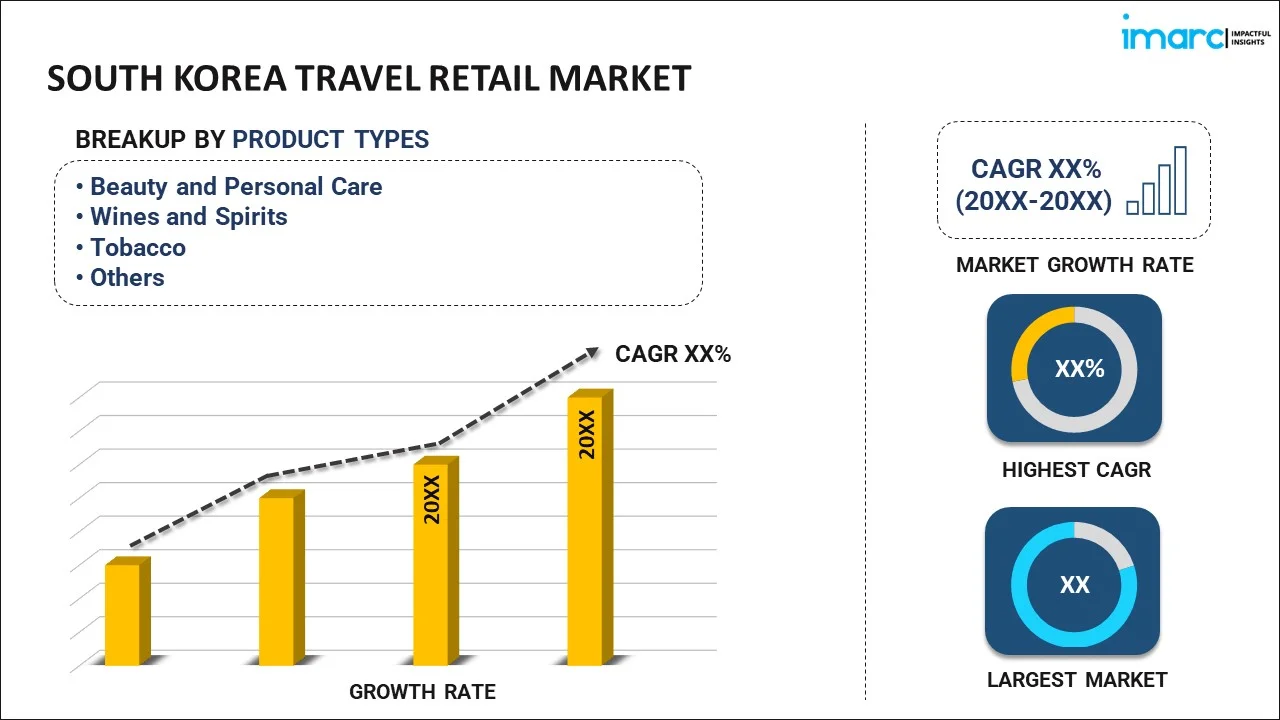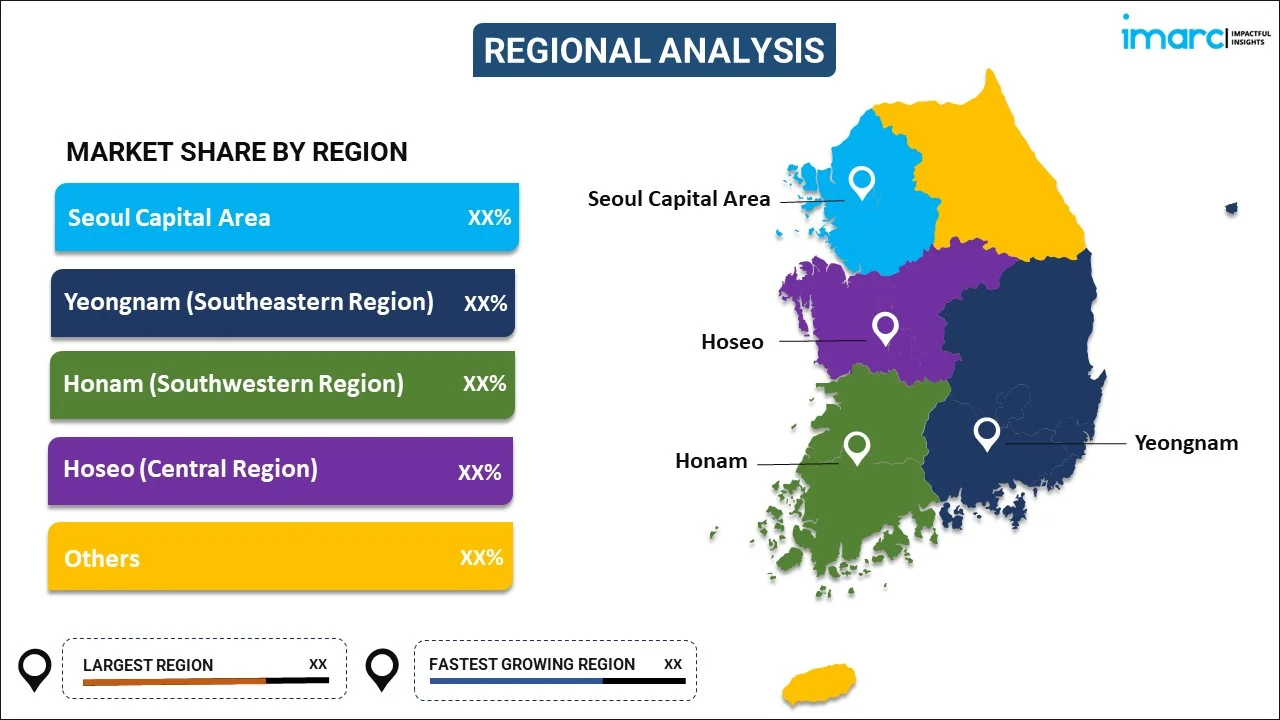
South Korea Travel Retail Market Report by Product Type (Beauty and Personal Care, Wines and Spirits, Tobacco, Eatables, Fashion Accessories and Hard Luxury, and Others), Distribution Channel (Airports, Airlines, Ferries, and Others), and Region 2025-2033
Market Overview:
South Korea travel retail market size reached USD 1.2 Billion in 2024. Looking forward, IMARC Group expects the market to reach USD 2.1 Billion by 2033, exhibiting a growth rate (CAGR) of 5.5% during 2025-2033. The expanding tourism industry, the increasing consumer inclination toward personalized shopping experiences that offer a taste of the local culture, and the integration of advanced technologies represent some of the key factors driving the market.
|
Report Attribute
|
Key Statistics
|
|---|---|
|
Base Year
|
2024
|
|
Forecast Years
|
2025-2033
|
|
Historical Years
|
2019-2024
|
|
Market Size in 2024
|
USD 1.2 Billion |
|
Market Forecast in 2033
|
USD 2.1 Billion |
| Market Growth Rate 2025-2033 | 5.5% |
Travel retail, often referred to as duty-free shopping, is a unique segment of the retail industry that caters to travelers at international airports, seaports, border crossings, and other transit hubs. It involves the sale of a wide range of products to passengers who are on international journeys. Travel retail outlets are strategically located in international transit points such as airports, cruise terminals, and land border crossings. These locations serve as gateways between countries and regions, making them ideal for reaching a diverse and global customer base. One of the defining features of travel retail is the availability of duty-free and tax-free shopping. Travelers can purchase products such as cosmetics, perfumes, alcohol, tobacco, electronics, fashion items, and luxury goods without paying certain import duties and taxes that would typically apply to these items when purchased within a country's borders. This tax advantage can result in significant savings for travelers. They also offer a platform for global brands to showcase their products to a diverse and international customer base. Luxury brands, in particular, are prominent in travel retail environments, as they seek to attract affluent travelers.
South Korea Travel Retail Market Trends:
One of the primary drivers of this market is the country's soaring tourism industry. South Korea has emerged as a sought-after destination for travelers from around the world, attracted by its rich cultural heritage, scenic beauty, and technological advancements. As the number of inbound tourists continues to surge, so does the demand for travel retail products and services. International visitors are keen to explore the unique assortment of goods that South Korea has to offer, from premium skincare products to traditional Korean attire. Consequently, businesses operating in the sector are presented with a lucrative opportunity to capitalize on this influx of tourists and bolster their revenue streams. Another pivotal driver shaping the market is the ever-evolving consumer preferences. Modern travelers seek not only convenience but also experiences. They are increasingly inclined toward personalized shopping experiences that offer them a taste of the local culture. South Korean travel retail outlets have adeptly adapted to this shift, providing travelers with an immersive shopping journey. This trend is particularly pronounced in the cosmetics and fashion segments, where travelers are drawn to unique South Korean beauty products and fashionable attire. Furthermore, technology is playing an instrumental role in reshaping the South Korea travel retail market. Digitalization and e-commerce have made significant inroads into this sector, enabling travelers to pre-order products online, access exclusive discounts, and even enjoy duty-free shopping experiences at the touch of a button. The integration of technology enhances the convenience factor for travelers and also allows businesses to gather valuable data on consumer preferences, enabling them to refine their product offerings and marketing strategies. In addition to these drivers, South Korea's commitment to infrastructure development has been a boon for the travel retail market. The nation's world-class airports and seaports provide an ideal canvas for businesses to establish their presence and cater to travelers efficiently.
South Korea Travel Retail Market Segmentation:
IMARC Group provides an analysis of the key trends in each segment of the market, along with forecasts at the country level for 2025-2033. Our report has categorized the market based on product type and distribution channel.
Product Type Insights:

- Beauty and Personal Care
- Wines and Spirits
- Tobacco
- Eatables
- Fashion Accessories and Hard Luxury
- Others
The report has provided a detailed breakup and analysis of the market based on the product type. This includes beauty and personal care, wines and spirits, tobacco, eatables, fashion accessories and hard luxury, and others.
Distribution Channel Insights:
- Airports
- Airlines
- Ferries
- Others
A detailed breakup and analysis of the market based on the distribution channel have also been provided in the report. This includes airports, airlines, ferries, and others.
Regional Insights:

- Seoul Capital Area
- Yeongnam (Southeastern Region)
- Honam (Southwestern Region)
- Hoseo (Central Region)
- Others
The report has also provided a comprehensive analysis of all the major regional markets, which include Seoul Capital Area, Yeongnam (Southeastern Region), Honam (Southwestern Region), Hoseo (Central Region), and Others.
Competitive Landscape:
The market research report has also provided a comprehensive analysis of the competitive landscape in the market. Competitive analysis such as market structure, key player positioning, top winning strategies, competitive dashboard, and company evaluation quadrant has been covered in the report. Also, detailed profiles of all major companies have been provided.
South Korea Travel Retail Market Report Coverage:
| Report Features | Details |
|---|---|
| Base Year of the Analysis | 2024 |
| Historical Period | 2019-2024 |
| Forecast Period | 2025-2033 |
| Units | Billion USD |
| Scope of the Report | Exploration of Historical and Forecast Trends, Industry Catalysts and Challenges, Segment-Wise Historical and Predictive Market Assessment:
|
| Product Types Covered | Beauty and Personal Care, Wines and Spirits, Tobacco, Eatables, Fashion Accessories and Hard Luxury, Others |
| Distribution Channels Covered | Airports, Airlines, Ferries, Others |
| Regions Covered | Seoul Capital Area, Yeongnam (Southeastern Region), Honam (Southwestern Region), Hoseo (Central Region), Others |
| Customization Scope | 10% Free Customization |
| Post-Sale Analyst Support | 10-12 Weeks |
| Delivery Format | PDF and Excel through Email (We can also provide the editable version of the report in PPT/Word format on special request) |
Key Questions Answered in This Report:
- How has the South Korea travel retail market performed so far and how will it perform in the coming years?
- What has been the impact of COVID-19 on the South Korea travel retail market?
- What is the breakup of the South Korea travel retail market on the basis of product type?
- What is the breakup of the South Korea travel retail market on the basis of distribution channel type?
- What are the various stages in the value chain of the South Korea travel retail market?
- What are the key driving factors and challenges in the South Korea travel retail?
- What is the structure of the South Korea travel retail market and who are the key players?
- What is the degree of competition in the South Korea travel retail market?
Key Benefits for Stakeholders:
- IMARC’s industry report offers a comprehensive quantitative analysis of various market segments, historical and current market trends, market forecasts, and dynamics of the South Korea travel retail market from 2019-2033.
- The research report provides the latest information on the market drivers, challenges, and opportunities in the South Korea travel retail market.
- Porter's five forces analysis assist stakeholders in assessing the impact of new entrants, competitive rivalry, supplier power, buyer power, and the threat of substitution. It helps stakeholders to analyze the level of competition within the South Korea travel retail industry and its attractiveness.
- Competitive landscape allows stakeholders to understand their competitive environment and provides an insight into the current positions of key players in the market.
Need more help?
- Speak to our experienced analysts for insights on the current market scenarios.
- Include additional segments and countries to customize the report as per your requirement.
- Gain an unparalleled competitive advantage in your domain by understanding how to utilize the report and positively impacting your operations and revenue.
- For further assistance, please connect with our analysts.
 Inquire Before Buying
Inquire Before Buying
 Speak to an Analyst
Speak to an Analyst
 Request Brochure
Request Brochure
 Request Customization
Request Customization




.webp)




.webp)












